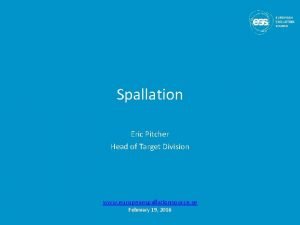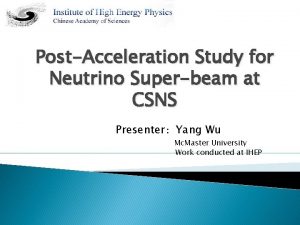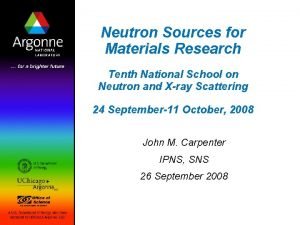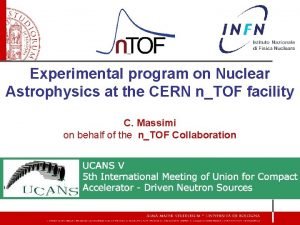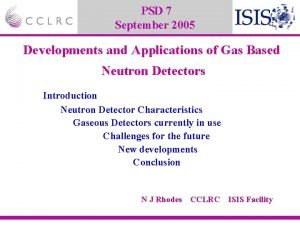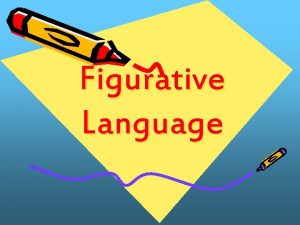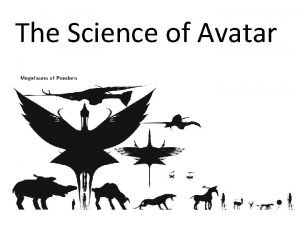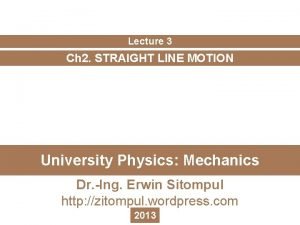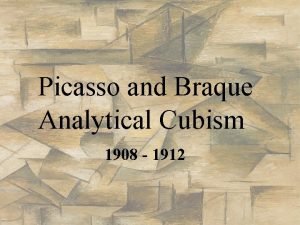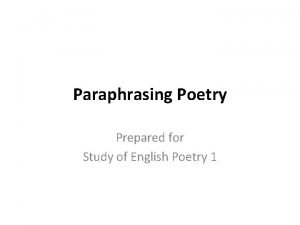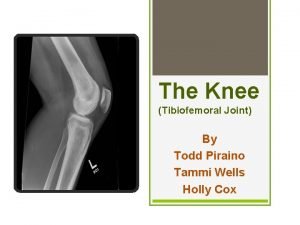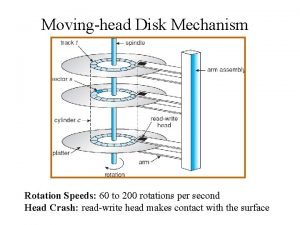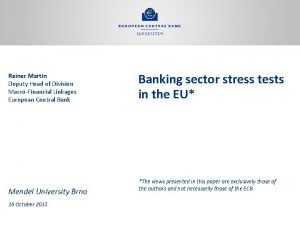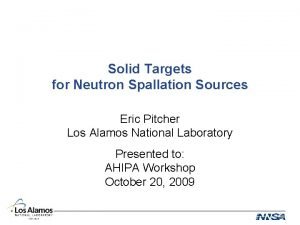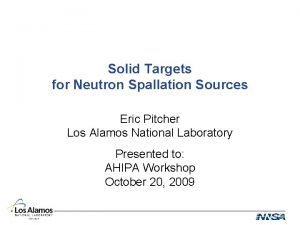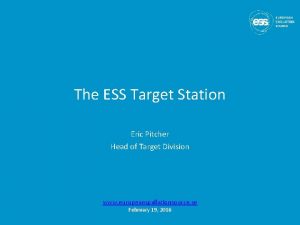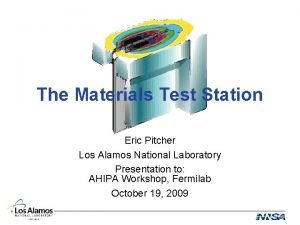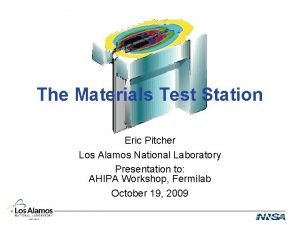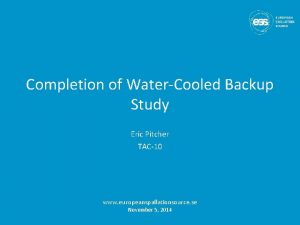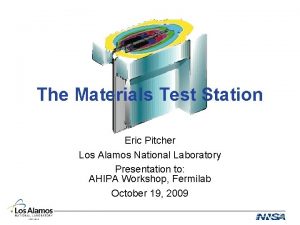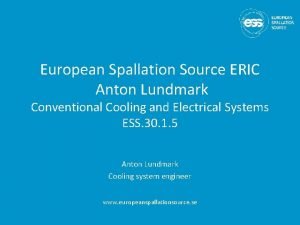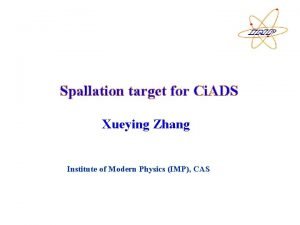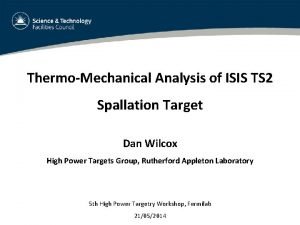Spallation Eric Pitcher Head of Target Division www
























- Slides: 24

Spallation Eric Pitcher Head of Target Division www. europeanspallationsource. se February 19, 2016

Outline • Preliminaries – Units of energy and length – Basic nuclear physics – Length scales and wavelengths • Spallation physics – Intranuclear cascade – Evaporation • Spallation neutron sources – – Neutron production Neutron thermalization Energy balance Radiation shielding 2

Units of energy • Electron-volt: e. V 1 e. V = 1. 6× 10– 19 joules 1 Me. V = 1. 6× 10– 13 joules 1 Ge. V = 1. 6× 10– 10 joules • Binding energy of the electron in a H atom ~10 e. V • Binding energy of a neutron in a nucleus ~10 Me. V Nuclear forces are about a million times greater than atomic forces. 3

To understand spallation, we need to start with some basic nuclear physics • The nucleus of an atom is a collection of neutrons and protons bound together by the strong nuclear force • Neutrons and protons bound together within a nucleus are called nucleons • Each nucleon is bound to the nucleus with a binding energy of about 8 Me. V • A hadron is a class of sub-atomic particle to which neutrons and protons belong 4

Length scales and wavelengths • De. Broglie wavelength λ = h/p h = the Planck constant p = particle momentum • A particle’s interaction length is on par with its wavelength • Wavelength of a 25 -me. V “thermal” neutron = 2 Å (same scale as the atomic spacing in a crystal lattice) • Wavelength of a 200 -Me. V proton = 2 fm (close to the distance between nucleons in a nucleus) 5

Nuclear spallation • Spallation is a nuclear reaction whereby a highenergy hadron strikes a nucleus and imparts energy to the nucleus, leading to the emission of a number of nucleons from it second stage: evaporation • Spallation proceeds in two stages: first stage: intranuclear cascade 6

First stage: intranuclear cascade Reaction probability • When passing through matter, a 200 -Me. V hadron with a 2 -fm wavelength interacts only with individual nucleons within a nucleus The probability of a spallation reaction occurring depends only on the average density of nucleons and not on nuclear properties. Material Nucleon density (per cm 3) Water 0. 6 x 1024 Aluminum 1. 6 x 1024 Tungsten 11. 5 x 1024 Mercury 8. 1 x 1024 7

First stage: intranuclear cascade Reaction outcome • The incident hadron transfers a fraction of its kinetic energy to the struck nucleon • The hadron-nucleon interaction may: – Transfer energy to the nucleus as a whole through subsequent interactions with neighboring nucleons, leaving the nucleus in a highly excited state first stage: intranuclear cascade – Produce pi mesons as reaction products – Eject the energetic and forward directed nucleon from the nucleus 8

Second stage: evaporation • The highly excited nucleus “boils” off nucleons, mostly neutrons, or clusters of nucleons as nuclei and hydrogen and helium atoms • For each nucleon emitted, the second stage: evaporation nucleus de-excites by the binding energy of the nucleon, which is about 8 Me. V • Each emitted neutron has 2 or 3 Me. V kinetic energy • These evaporation particles are emitted nearly isotropically 9

Neutron thermalization: Slowing down energetic neutrons • Most neutrons produced via spallation have kinetic energies of a few Me. V for which the de. Broglie wavelength is 10 to 20 fm • For neutron scattering applications, neutrons need wavelengths in the range of 1 to 30 Å energies of 1 to 80 me. V • Spallation neutrons must be slowed by nine orders of magnitude in energy Energy distribution of neutrons produced via spallation by 1. 7 -Ge. V protons on tungsten 10

Spallation sources: Potential applications • Neutron scattering research • Nuclear waste transmutation / energy production • Isotope production – Rare isotopes for nuclear physics research – Medical isotopes – Research isotopes • Neutron source for nuclear physics research and nuclear cross section measurement • Irradiation facility for radiation damage studies 11

Neutron production versus beam energy • After a few hundred Me. V, neutron production is linear with energy up to a few Ge. V • Some loss occurs at high energies for finite-sized targets Neutron production versus beam energy for a 50 -cm-diam by 200 -cm-long tungsten cylinder bombarded on axis by protons. 12

Neutron production versus beam power • From 1 – 3 Ge. V, neutron production is linear with beam power and independent of beam energy 13

Proton passage through matter • Due to their electric charge, protons lose energy as they pass through matter due to interactions with bound electrons • Bragg peak at the end of the track is prominent at low energy • Protons are also removed from the beam through nuclear interactions 14

Energy Balance • Spallation is an endothermic reaction: A portion of the proton beam’s kinetic energy is converted to mass • Mass conversion is equal to the amount of energy that goes into releasing neutrons from the nucleus • For the ESS operating at 5 MW beam power, Heating of structures 4. 0 MW Conversion to mass 0. 9 MW At full power, target station increases Neutrinos 0. 1 MW in mass by 0. 2 mg/year 15

Neutron thermalization: The Maxwell-Boltzmann distribution • Neutron thermalization is the process of reaching thermodynamic equilibrium with the scattering medium • We use hydrogenous media to slow and thermalize neutrons – Water at ~room temperature (300 K) thermal moderator – Liquid hydrogen at cryogenic temperature (20 K) cold moderator • A neutron can transfer nearly all of its energy to a hydrogen nucleus in a single collision • It takes typically 15 to 25 collisions with hydrogen to slow a 2 -Me. V neutron to near thermal energy 16

The target station produces neutrons, slows them, and leaks them to neutron guides Beryllium reflects neutrons that might otherwise escape, boosting performance by a factor of 5 Liquid hydrogen moderator at 20 K 2 -Ge. V proton conversion efficiency ~ 10– 5 neutron guide (start of the neutron scattering instrument) cold neutrons tungsten target produces about 60 neutrons per proton ≈ 1018 neutrons per second

Shielding a spallation source • High-energy neutrons have a relatively small probability of interaction (denoted by σT) with matter 18

High-energy neutrons are not only penetrating, they cause high dose Source: D. Filges and F. Goldenbaum, Handbook of Spallation Research, Wiley-VCH, 2009. 19

Concrete is most effective for shielding low-energy neutrons Source: D. Filges and F. Goldenbaum, Handbook of Spallation Research, Wiley-VCH, 2009. 20

Practical solution for shielding a spallation source: Lots of steel and concrete • Steel effectively attenuates high energy neutrons and gammas • Concrete attenuates lower energy neutrons but creates gammas in the process • Often, laminated shields of steel and concrete are most effective Dose as a function of depth in a 1. 5 -m-thick iron shield followed by 50 cm of concrete. The source is a pencil beam of 600 -Me. V protons normally incident on the iron slab.

Radioactivity and Decay Heat • Radioactivity is a byproduct of the spallation process • The emitted particles, mostly betas and gammas, deposit heat in the radioactive material and surrounding structures 22

For further reading on spallation and spallation neutron sources • D. Filges and F. Goldenbaum, Handbook of Spallation Research, Wiley-VCH, 2009. 23

Thanks for your attention!
 Eric pitcher
Eric pitcher Spallation neutron source
Spallation neutron source Spallation neutron source
Spallation neutron source Spallation neutron source
Spallation neutron source Spallation neutron source
Spallation neutron source A baseball pitcher won 80 percent
A baseball pitcher won 80 percent Theme of the crow and the pitcher
Theme of the crow and the pitcher Literal vs figurative examples
Literal vs figurative examples Pitcher,strike,home plate,glove
Pitcher,strike,home plate,glove Direhorse pitcher plant
Direhorse pitcher plant A pitcher tosses a baseball up along y axis
A pitcher tosses a baseball up along y axis Analytical cubism characteristics
Analytical cubism characteristics Paraphrase poem example
Paraphrase poem example Primary target market and secondary target market
Primary target market and secondary target market Biceps femoris innervation
Biceps femoris innervation Shins body
Shins body 7 tones
7 tones The attacking firm goes head-to-head with its competitor.
The attacking firm goes head-to-head with its competitor. Indexing head formula
Indexing head formula What is a tonic syllable
What is a tonic syllable Moving head disk mechanism
Moving head disk mechanism Html teksta noformēšana
Html teksta noformēšana Flooded suction pump
Flooded suction pump Moving head disk mechanism
Moving head disk mechanism Deputy head of division
Deputy head of division
